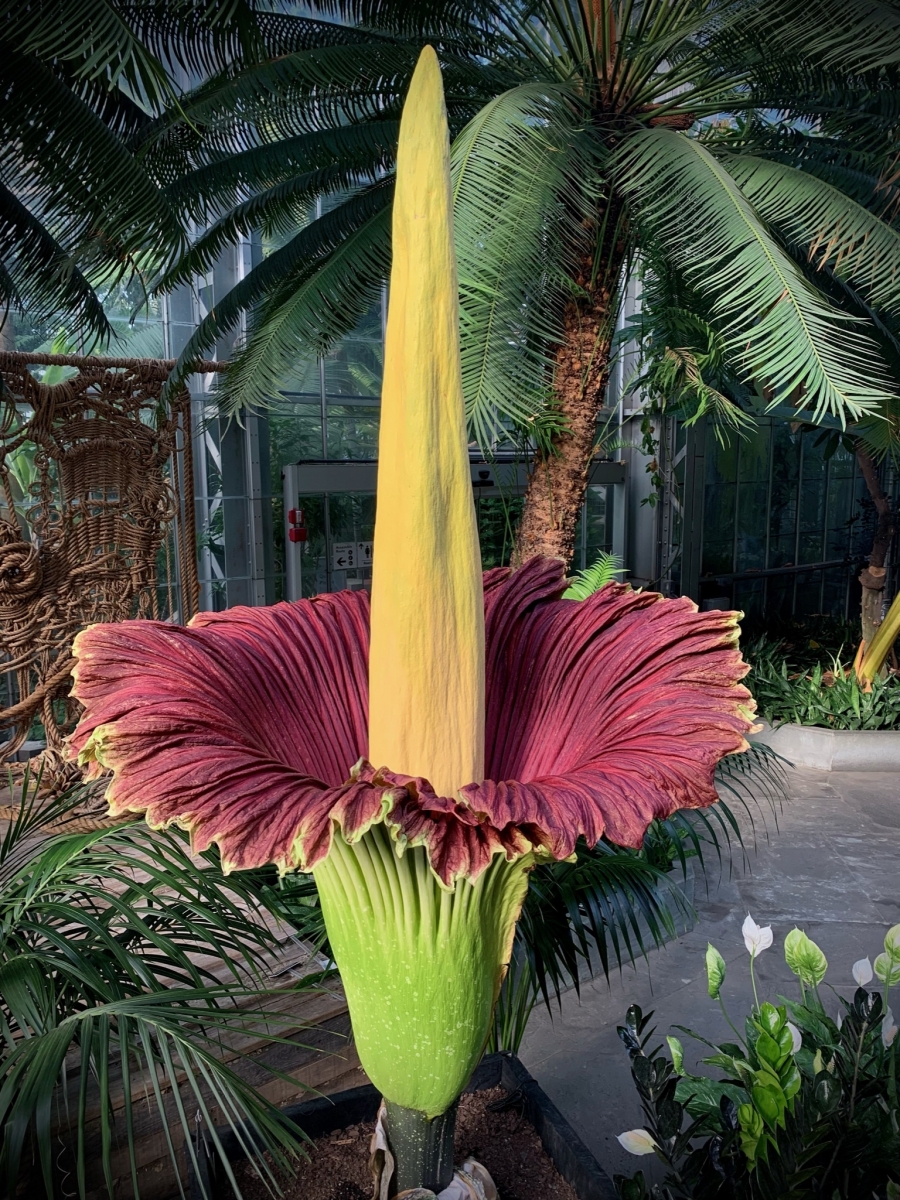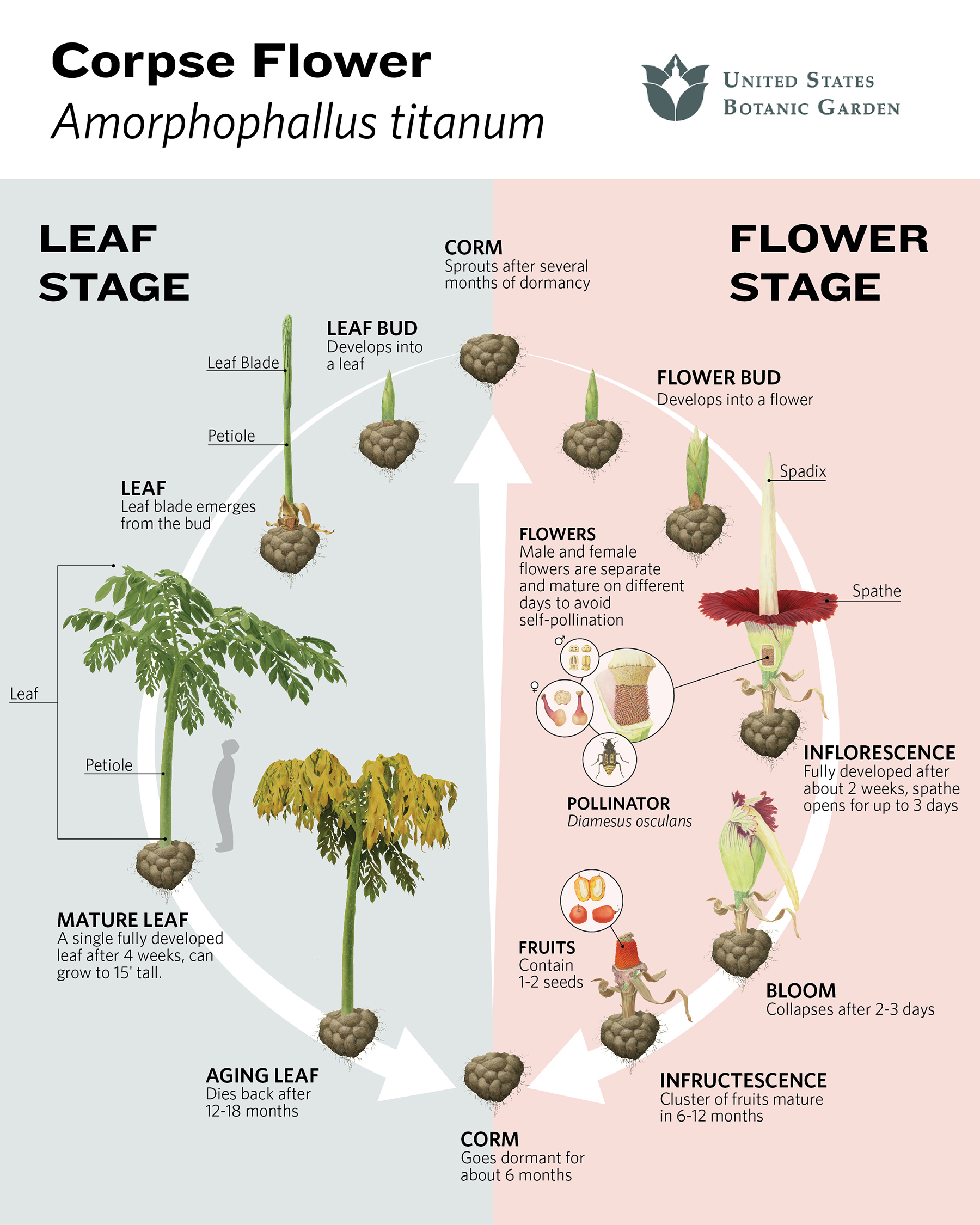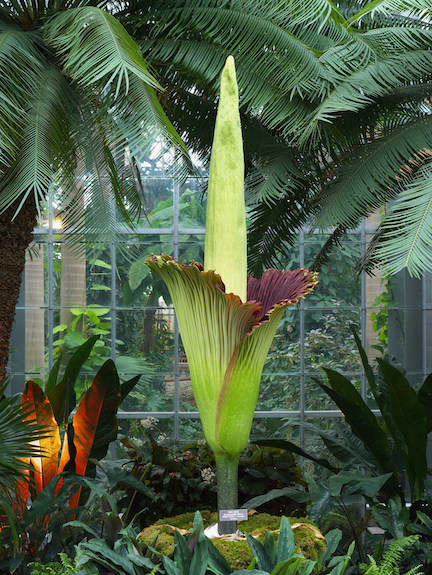The corpse flower (Amorphophallus titanum) is the largest unbranched inflorescence in the plant kingdom, boasts a powerful stink, and blooms for just 2-3 days once every two to three years. The bloom can grow up to 9 feet tall! This plant fascinates visitors of all ages. Explore the science and conservation work at the U.S. Botanic Garden below!
The U.S. Botanic Garden has a sizeable number of mature corpse flower plants in our collection as part of our conservation work, so if you miss one bloom, don't fret — just keep watching. We expect multiple corpse flower blooms per year. This page will be updated anytime one is coming into bloom.
August 2025 -- A corpse flower (Amorphophallus titanum) permanently planted in our Tropics house bloomed August 5. Measured at 90 inches tall, it began opening around 3:40 pm that day, fully opening that evening and smelling Tuesday evening and a little Wednesday. We expect the bloom could stand 2-3 days, possibly collapsing around August 8. See videos and photos on our Facebook or Instagram pages.
This particular plant is over 8 years old, and bloomed in 2017 and 2021. We believe this might be the first time in North America that a corpse flower planted permanently in the ground in a public garden is blooming. They are normally grown in pots in greenhouses with very high heat and humidity.
July 2024 -- Two corpse flowers (Amorphophallus titanum) were on display to the public July 2024.
About the two plants:
Accession 2019-0033 is the fifth bloom of the seedlings USBG created via pollination in 2017.
The seeds were sown in 2018, meaning the plant is about six years old. This is its first time blooming.
Accession 2007-1033 has bloomed once before in 2016. In fall 2018, this plant was almost lost to rot in the corm. In 2020, the apex died, and a large number of sprouts came up — the tuber broke into 22 individuals. The largest 3 were chosen to recover the accession, and the USBG Horticulture team has retained one to keep this accession alive. It was planted in 2021, and this is its first bloom since then. This iteration of the plant is 4 years old.
May 2024 -- our second corpse flower bloom of 2024 opened May 4. This 6-year-old has never bloomed before. It is the result of our hand-pollination using two of our blooms in 2017. It stands 83", as of May 4. Most blooms usually stand for 3-4 days, though the stinky smell is mostly just during the first 12-24 hours when the female flowers are receptive to pollination. Find it in the back of our Tropics house. The Conservatory is open daily 10 am - 5 pm. No tickets required.
April 2024 -- our first corpse flower bloom of 2024 opened the evening of April 24. It was 85" tall.
Corpse Flower and Aroid Conservation
The corpse flower (Amorphophallus titanum) is listed as Endangered by the International Union for Conservation of Nature (IUCN), with an estimation of fewer than 1,000 individuals remaining in the wild. IUCN estimates the population has declined more than 50% over the past 150 years. The main reasons for the decline are logging and the conversion of the plant’s native forest habitat to oil palm plantations.
The U.S. Botanic Garden is participating in conservation work related to Amorphophallus titanum and aroids plants. Diversity amongst the gene pool is important for successful conservation of endangered plants held in ex situ conservation collections such as at botanic gardens. The U.S. Botanic Garden helped fund a conference in partnership with Botanic Garden Conservation International on aroid conservation in 2018 that was attended by botanic garden professionals from around the world. As an offshoot from this, many botanic gardens are participating in a national A. titanum conservation project headed by Chicago Botanic Garden.
The goal of the project is to identify and create a database of the genetic makeup of A. titanum plants currently in botanic garden collections. This information will be used to ensure a broadening of the gene pool by creating diversity amongst new offspring by cross-pollination of diverse parent plants. The USBG has gathered and submitted plant material from our A. titanum collection to be added into the database. We hope to be able to acquire pollen based on this project to create diverse offspring. The Garden also plans to collect pollen to store for future use by other botanic gardens in this project.
What Makes the Corpse Flower Special?
The allure of the corpse flower comes from its great size (it is the largest unbranched inflorescence in the plant kingdom), powerful stink, and fleeting presence. The plants frequently grow up to 8 feet tall in cultivation. Its putrid smell is most potent during peak bloom at night into the early morning. The odor is often compared to the stench of rotting flesh. The inflorescence (a collection of flowers acting as one) also generates heat, which allows the stench to travel further. This combination of heat and smell efficiently lures corpse-attracted pollinators, such as carrion beetles and flies, from across long distances.
The corpse flower does not have an annual blooming cycle. The bloom emerges from, and energy is stored in, a huge underground stem called a "corm." The plant blooms only when sufficient energy is accumulated, making time between flowering unpredictable, spanning from a few years to more than a decade. It requires very special conditions, including warm day and night temperatures and high humidity, making botanic gardens well suited to support this strange plant outside of its natural range.
This plant is native to the tropical rainforests of Sumatra, Indonesia, and first became known to science in 1878. In its natural habitat, the corpse flower can grow up to 12 feet tall. Public viewings of this unique plant have occurred a limited number of times in the United States. The U.S. Botanic Garden has displayed blooming corpse flowers in 2003, 2005, 2007, 2010, 2013, 2016, 2017 (three blooms), 2020 (two blooms), 2021, and 2022 (four blooms), 2023, and 2024 (four blooms).
Watch a Bloom Time Lapse
Watch a time lapse of a previous corpse flower bloom growing, opening, and collapsing here at the U.S. Botanic Garden. You can explore recordings of live Q&A programs, pollination, conservation, and more in video archive playlist.
Determining Bloom Versus Leaf
Join gardener Stephen to find out what clues he used to determine a previous bud (2020) was a bloom and not a leaf:
Corpse Flower Lifecycle Infographic
(click to see large version):
Chemistry of its smell
Learn more about the plant and its unique smell in this video we helped create:
Corpse flower lifecycle and pollination
Check out this video we helped create about the corpse flower's lifecycle, smell, and reproduction:
We shared the 2016 plant's life cycle via a live webcam, which has now ended. In addition to this video from the morning it started opening, August 2, 2016, you can find all the live webcam videos on our YouTube channel. If you visited, find your date and see yourself with the corpse flower!
Photo of 2013 corpse flower bloom:
The U.S. Botanic Garden has displayed blooming corpse flowers in 2003, 2005, 2007, 2010, 2013, 2016, 2017 (three blooms), and 2020 (two blooms), 2021, and 2022 (four blooms). More than 130,000 people came to see the 2017 bloom in person, and more than 650,000 viewers accessed the live webstream.
- Learn more about the 2021 bloom.
- Learn more about the two 2020 blooms.
- Learn more about the three 2017 blooms.
- Learn more about the 2016 bloom.
- Learn more about the 2013 bloom.
About the 2022 Corpse Flower Plants
The first Amorphophallus titanum to bloom in 2022 was 9 years old, grown from seed. It was a sibling to a previous bloom that bloomed at 8 years old. The spadix was first seen on May 23, 2022. The plant was measured at 52" in height on that day. (See daily height updates below.) The bloom opened on the evening of June 2, 2022, at a height of 97".
The Garden sent a second bloom to Philadelphia in June 2022 as part of a special display spotlighting our aroid collecting in the Philadelphia Flower Show. The plant was sent to Longwood Gardens after the Flower Show, where it bloomed on June 24, 2022, at a height of 76".
The third bloom in 2022 was put on display in the Garden Court on June 23, 2022. It is the fourth bloom for this plant, which previously bloomed in 2013, 2017, and 2019. The plant is 16 years old, making it the oldest in our collection.
We shared a fourth 2022 corpse flower bloom with our friends at Smithsonian Gardens, where it is was on display in the Enid A. Haupt Garden behind the Smithsonian Castle. It opened in peak bloom the evening of August 9, 2022, standing 102" tall. The bloom collapsed and was removed on Aug. 15, 2022. It was the second bloom for this plant, which previously bloomed in 2020. The plant was 10 years old.


